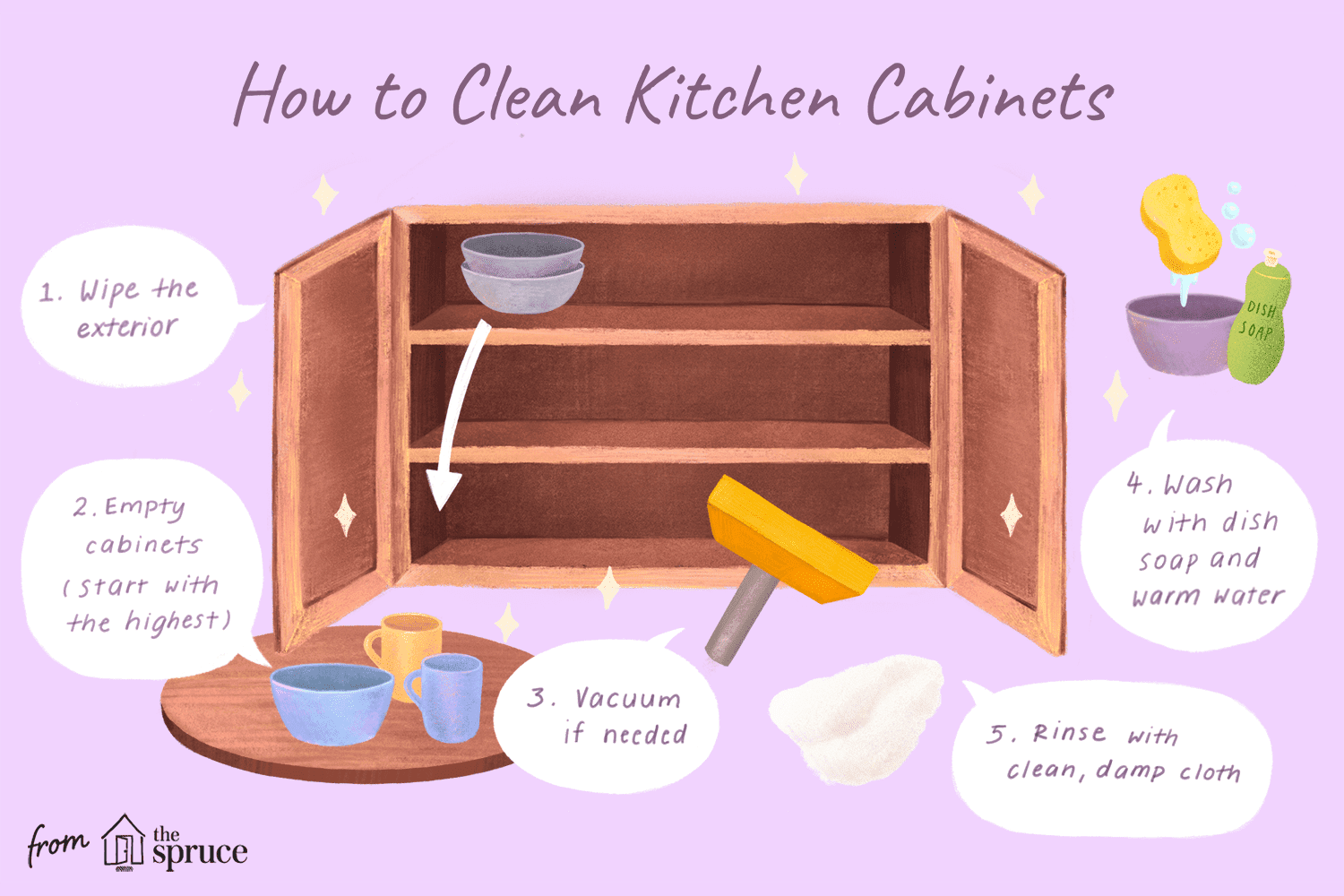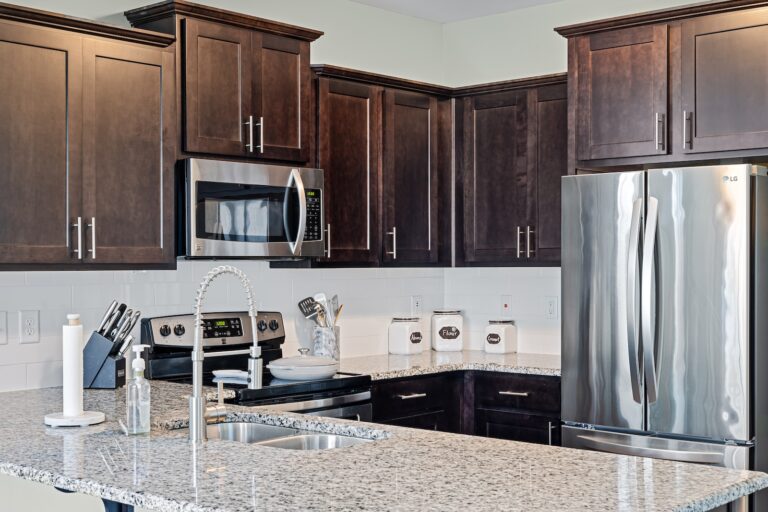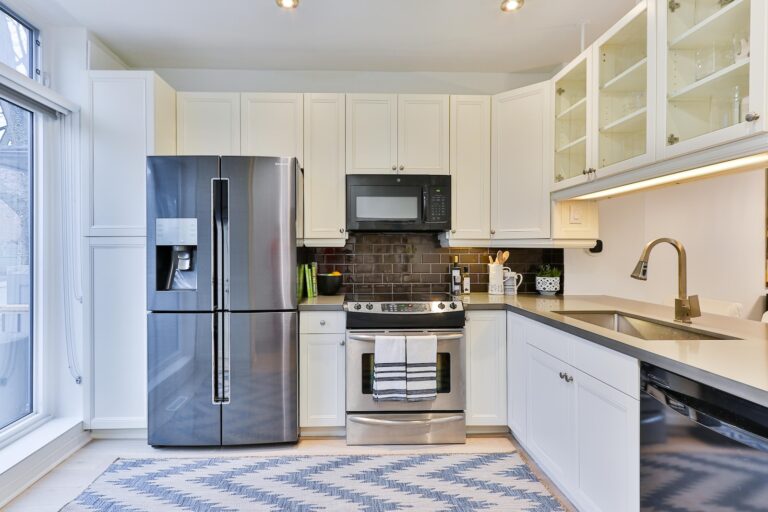How To Deep Clean Kitchen Cabinets?
The kitchen is the heart of the home, and the cabinets are its backbone. They hold all of our cookware, dishes, and food, but they can also collect grease, dirt, and grime over time. Deep cleaning your kitchen cabinets may seem daunting, but with the right tools and techniques, it can be a satisfying and rewarding task.
In this article, we will guide you through the steps to deep clean your kitchen cabinets, from removing the contents and hardware to scrubbing away the dirt and grime. Whether you’re a seasoned pro or a beginner, our tips and tricks will help you achieve sparkling clean cabinets in no time. So roll up your sleeves and let’s get started!
- Remove all items: Empty the cabinets and drawers completely.
- Clean the interior: Use a cleaning solution to wipe down the interior of the cabinets.
- Clean the exterior: Wipe down the doors, handles, and knobs with a cleaning solution.
- Polish the wood: Apply wood polish to the exterior of wooden cabinets.
- Reorganize: Reorganize the items and place them back into the cabinets and drawers.

Deep Cleaning Kitchen Cabinets: A Step-by-Step Guide
Keeping your kitchen cabinets clean and organized is essential to maintaining a healthy and functional kitchen. Over time, grease, grime, and dirt can build up on your cabinets, making them look dull and uninviting. Deep cleaning your kitchen cabinets is a great way to restore their shine and keep them looking their best. Here’s how to do it.
Step 1: Remove Everything from Your Cabinets
The first step in deep cleaning your kitchen cabinets is to remove everything from them. This will give you a clear view of what needs to be cleaned and will allow you to access all the surfaces of your cabinets. Take everything out of your cabinets and place it on your kitchen counter or table.
Once your cabinets are empty, use a vacuum or duster to remove any loose dirt or debris from the interior of your cabinets. This will make the cleaning process easier and more effective.
Step 2: Clean the Exterior of Your Cabinets
The next step is to clean the exterior of your cabinets. Begin by mixing a solution of warm water and a mild detergent. Dip a soft cloth or sponge into the solution and wring it out well. Wipe down the exterior of your cabinets, paying particular attention to areas that are prone to grease and grime buildup, such as around the knobs and handles.
For stubborn stains or grease buildup, you may need to use a stronger cleaning solution. Mix equal parts vinegar and water, and use a soft cloth or sponge to apply the solution to the affected areas. Rinse with warm water and dry with a clean cloth.
Step 3: Clean the Interior of Your Cabinets
Once the exterior of your cabinets is clean, it’s time to move on to the interior. Begin by mixing a solution of warm water and a mild detergent. Dip a soft cloth or sponge into the solution and wring it out well. Wipe down the interior of your cabinets, paying particular attention to areas that are prone to food and liquid spills.
For tough stains or spills, you may need to use a stronger cleaning solution. Mix equal parts baking soda and water to form a paste. Use a soft cloth or sponge to apply the paste to the affected areas. Let it sit for a few minutes, then wipe away with a clean, damp cloth.
Step 4: Clean the Cabinet Shelves
The next step is to clean the shelves inside your cabinets. Remove the shelves and wash them in warm, soapy water. Rinse with warm water and dry with a clean cloth. If your shelves are made of wood, you may need to oil or polish them to keep them looking their best.
Step 5: Clean the Cabinet Doors
The cabinet doors are often overlooked when it comes to cleaning, but they can accumulate a lot of dirt and grease over time. Use a soft cloth or sponge and warm, soapy water to clean the doors of your cabinets. Pay particular attention to areas around the knobs and handles, where grease and grime tend to accumulate.
Step 6: Clean the Cabinet Hardware
The hardware on your cabinets, such as knobs and handles, can also accumulate dirt and grime over time. Use warm, soapy water and a soft cloth to clean the hardware on your cabinets. If the hardware is particularly dirty, you may need to remove it from the cabinets and soak it in warm, soapy water for a few minutes before cleaning.
Step 7: Dry Everything Thoroughly
Once you’ve finished cleaning your kitchen cabinets, it’s important to dry everything thoroughly. Use a clean, dry cloth to wipe down the interior and exterior of your cabinets, as well as the shelves and hardware. Leaving any moisture behind can lead to mold and mildew growth, which can be harmful to your health.
Step 8: Reorganize Your Cabinets
Now that your cabinets are clean and dry, it’s time to put everything back where it belongs. Take this opportunity to reorganize your cabinets and get rid of any items that you no longer need or use. This will help to keep your cabinets organized and clutter-free, making it easier to find what you need when you need it.
Step 9: Maintain Your Clean Cabinets
To keep your kitchen cabinets looking their best, it’s important to maintain them on a regular basis. Wipe down the interior and exterior of your cabinets with a soft cloth or sponge and warm, soapy water once a week. This will help to remove any dirt or grime before it has a chance to build up.
Step 10: Benefits of Deep Cleaning Your Kitchen Cabinets
There are many benefits to deep cleaning your kitchen cabinets. In addition to making them look their best, deep cleaning can also help to eliminate harmful bacteria and allergens that can accumulate on your cabinets over time. By keeping your cabinets clean and well-maintained, you’ll also be able to extend their lifespan and avoid costly repairs or replacements down the line.
In conclusion, deep cleaning your kitchen cabinets is an essential part of maintaining a healthy and functional kitchen. By following the steps outlined in this guide, you’ll be able to restore the shine to your cabinets and keep them looking their best for years to come. So don’t wait – start deep cleaning your kitchen cabinets today!
Frequently Asked Questions
Are you wondering how to deep clean your kitchen cabinets? Here are some common questions and answers to help you get started.
What supplies do I need for deep cleaning kitchen cabinets?
Before beginning the deep cleaning process, make sure you have the necessary supplies. You will need a bucket, warm water, dish soap, microfiber cloths, a toothbrush, and a degreaser. A degreaser is especially important if you have built-up grease on your cabinets. You may also want to wear gloves to protect your hands.
It’s important to note that if you have cabinets made of a special material, such as wood or stainless steel, you may need specific cleaning products. Always check the manufacturer’s recommendations before using any new products on your cabinets.
How do I remove built-up grease from my cabinets?
Built-up grease is a common problem in kitchens, especially on cabinets located above the stove. To remove the grease, you can use a degreaser or a mixture of warm water and dish soap. Apply the cleaner to a microfiber cloth and gently scrub the cabinets. You may need to use a toothbrush to get into the crevices and corners of the cabinets. Rinse the cabinets with clean water and dry them with a clean cloth.
It’s important to clean up any spills and splatters on your cabinets as soon as possible to prevent the grease from building up in the first place.
How often should I deep clean my kitchen cabinets?
The frequency of deep cleaning your kitchen cabinets will depend on how much you use your kitchen and how quickly they get dirty. As a general rule, it’s a good idea to deep clean your cabinets at least once a year. However, if you notice that they are getting dirty more quickly, you may need to deep clean them more often.
Regular cleaning and maintenance, such as wiping down the cabinets after cooking and cleaning up spills immediately, can help prolong the time between deep cleanings.
How do I clean wooden kitchen cabinets?
Cleaning wooden cabinets requires a bit more care than cleaning other types of cabinets. Avoid using harsh chemicals or abrasive materials that can scratch or damage the wood. Instead, mix warm water and dish soap and apply it to a microfiber cloth. Wipe down the cabinets in the direction of the wood grain. Rinse the cabinets with clean water and dry them with a clean cloth.
If your wooden cabinets are stained or have a protective finish, use a cleaner specifically designed for those types of cabinets. Always follow the manufacturer’s instructions for best results.
Can I use vinegar to clean my kitchen cabinets?
Vinegar is a natural cleaner that can be used to clean many surfaces, including kitchen cabinets. However, it’s important to dilute the vinegar with water to avoid damaging your cabinets. Mix equal parts water and vinegar in a spray bottle and spray the solution onto a microfiber cloth. Wipe down the cabinets and rinse with clean water. Dry the cabinets with a clean cloth.
While vinegar can be an effective cleaner, it may not be suitable for all types of kitchen cabinets. Always check the manufacturer’s recommendations before using any new products on your cabinets.

How to quickly CLEAN CABINETS & REMOVE GREASE & GUNK!!! | Andrea Jean
In conclusion, deep cleaning your kitchen cabinets is an essential task that should be carried out regularly. By taking the time to thoroughly clean your cabinets, you can ensure that they remain in good condition and avoid the buildup of grime and dirt.
Remember to start by removing all items from the cabinets, including shelves and drawers. Use warm, soapy water to clean the surfaces thoroughly, and don’t forget to wipe down the interior of the cabinets as well.
Finally, once you’ve finished cleaning, take the time to organize your items before returning them to the cabinets. This will ensure that your cabinets remain tidy and easy to use, making your time in the kitchen much more enjoyable. With these tips in mind, you’ll be well on your way to achieving a sparkling clean kitchen!






